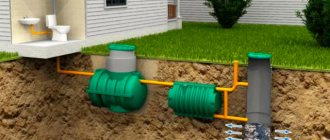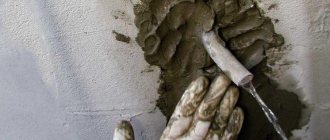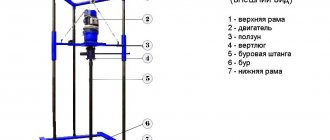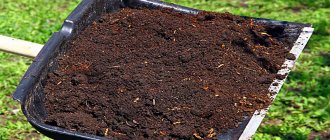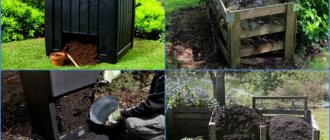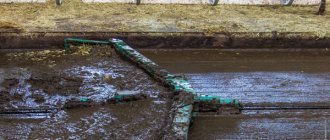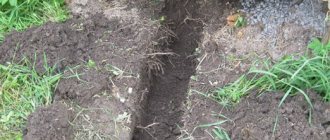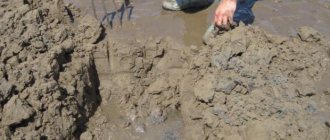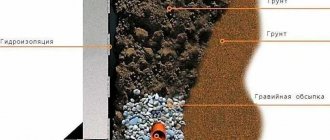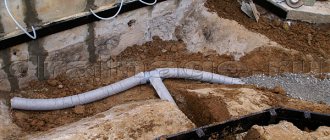If your suburban area is located in a lowland or the groundwater is high, then you should think about installing a drainage system; fortunately, you can choose to create high-quality drainage - with your own hands or by ordering the services of specialists. Without drainage, you will be completely disappointed when living outside the city - the basement will constantly flood, dampness will begin to destroy the foundation, and you will not be able to get rid of puddles on the site.
A drainage device will help solve two problems at once:
- Drain water that falls in the form of precipitation from the site,
- Drain high groundwater.
The costs will pay off handsomely, since the site and basement will be dry, the owners will not have to jump over puddles, and there will be no dampness in the basement.
Drainage of groundwater will protect the foundation and root system of plants from destruction, and drainage of water from rain and melting snow will help transform the area from a swamp into a beautiful lawn.
The arrangement of drainage consists of several stages:
- Design,
- Installation of drainage (surface or deep).
What is drainage?
The answer lies in the very name of the building. Literally, drainage means removing water from the surface of the earth or draining water within the soil.
Drainage happens:
- Artificially created;
- A natural phenomenon.
We, as drainage specialists, and you, as those suffering from excess moisture on the site, are interested in the first option - to rid your territory of oversaturation with surface groundwater using artificially created methods of draining excess water. The implementation of the drainage project is carried out on a turnkey basis throughout the entire area.
Site drainage and wells
Stormwater or groundwater interfere with the use of wells by creating excessive pressure on the walls of the mine, which causes:
- Displacement of reinforced concrete formwork;
- Mine ring ruptures;
- Silting of the bottom;
- Muddy water in the well.
We recommend that owners of plots with drinking wells located on their area drain the soil for normal use of the autonomous source.
If the soil is highly saturated, the hydraulic structure will have to be serviced 70% more often:
- Due to pressure - repair reinforced concrete rings;
- Due to the displacement of the rings, clean the bottom of the well.
Drainage laying diagram
The photo shows a diagram for calculating, constructing and installing drainage on a site with all the necessary components:
- Drainage (well for drainage) and rain well with covers for storm drainage;
- Storm water inlets with sand traps and filters for rainwater runoff;
- Collector;
- Plastic inspection well;
- Corrugated HDPE drainage pipes 110, 200, 300 mm (with perforation);
- Pipe for draining groundwater.
Materials
To make cottage drainage, the following materials may be required:
- sand with a fraction size of at least 2 mm;
- crushed stone without screenings and dust (can be replaced with gravel);
- perforated drainage pipes;
- geotextiles;
- concrete trays, rings, metal gratings.
It is better to choose plastic pipes for drainage. They are inexpensive, have a long service life, are flexible and easy to install. Pipes made of asbestos, metal and ceramics are also suitable. But they have more disadvantages compared to polymer drains. When purchasing pipes, you need to know their throughput capacity, which is correlated with the volume of water that needs to be removed from the site (m3/day).
Hidden dangers of abundant surface-ground water on site
Ground surface waters exist in areas of the earth with established stable natural phenomena:
- The location of one or more large bodies of water nearby;
- The location of springs and springs close to the surface of the earth;
- High-lying water horizon;
- The site is located on land with a high peat content, which absorbs moisture like a sponge and holds it in itself.
The danger of oversaturation with moisture threatens areas located in lowlands. But this is rather a seasonal phenomenon, occurring during heavy rains.
Excessive humidity requires its owner to create a drainage system. This is an effective solution for collecting groundwater, storm water, and melt water. Without drainage, the soil in a summer cottage will be excessively moistened, and this will have consequences that will affect the walls of the house, the condition of its basement, and the planting of vegetable crops.
Obligate drainage
In what situations is drainage necessary? Each respondent answered this question according to his own understanding (Table 9). From a purely practical point of view:
1. In the first place, and this is true, is the possibility of leakage of bile or pancreatic juice. These fluids are easily collected and evacuated by drainage, which, when installed in cases of biliary and pancreatic leakage, can be life-saving and have a therapeutic effect.
2. The second indication is an abscess containing pus. Some surgeons believe that a well-formed cavity containing pus requires drainage. Many respondents attach importance to terms such as “undrained abscess” or “thick-walled abscess” as an indication for drainage. I'm surprised that such abscesses are actually found in the abdominal cavity!
3. The third general point is insufficient control over the source of infection. A variety of indications appear here, such as bile leakage, urination, the impossibility of forming a full-fledged external fistula of the duodenum or jejunum without an intermediate cavity, which is quite reasonable.
4. Difficult duodenal stump – danger of incompetence after gastric resection according to B-2.
5. Other situations such as the danger of urination, the danger of leakage of the esophageal suture line, which is also reasonable. Regarding the danger of possible bleeding, which, as a rule, is unnecessary and is rarely performed. Even with significant bleeding, this is just the tip of the iceberg.
Table 9. In what situation will you install drainage?
| Situations | Number of respondents | Comments | |
| 1. | High probability of leakage of bile or pancreatic juice | 37 | |
| 2. | Proven abscess containing pus | 31 | Many people attach importance to “thick walls” or “an abscess that has not collapsed” |
| 3. | Lack of satisfaction from complete “source control” | 11 | Some say: "when I expect expiration" |
| 4. | Difficult duodenal suture line | 6 | |
| 5. | High chance of urine leakage | 4 | |
| 6. | Esophageal suture line | 2 | |
| 7. | Expected bleeding | 3 | Typically drain for 24-48 hours |
Why is drainage needed?
The drainage system looks like a branched configuration of pipes connected to each other. They are located on the territory under the site, or around the house. Water in the ground flows into the system. Each drainage pipe has several small diameter holes through which liquid falls. Backfilling occurs with large gravel, crushed stone, and sand.
The water collected from the site ends up in storm water inlets or a drainage (storm) well for collection, which also belongs to the soil drainage system. The hydraulic structure is being dug at the lowest point of the dacha.
Lack of drainage will lead to rotting of the roots of garden and vegetable garden plants, flooding of basements and first floors. In winter, the foundation, saturated with moisture, begins to crack, which leads to its destruction.
Acute cholecystitis
Nowadays, the surgeon often performs “difficult” laparoscopic cholecystectomy (LCE) in patients with advanced acute cholecystitis. The preparation is not easy, the time is considerable, and the discharge from the liver causes outrage. To complete the procedure, a transition to laparotomy is possible. The question remains: is it reasonable to leave drainage in the area of the gallbladder bed or under the liver? A third of respondents will answer “YES” (Table 4). Please note that the emphasis in the question was on the expression “routine drainage”. Many respondents leave it selectively, in case of unfavorable closure of the cystic stump or in anticipation of active exudation.
Table 4. Do you place drainage after open cholecystectomy (OCE) or LCE for severe acute cholecystitis?
| Quantity | No | Yes | |
| North America | 18 | 12 | 6 |
| Western Europe | 10 | 8 | 2 |
| Eastern Europe | 7 | 1 | 6 |
| Latin America | 15 | 14 | 1 |
| Asia | 15 | 7 | 8 |
| Australia | 3 | 2 | 1 |
| South Africa | 3 | 3 | |
| Total | 71 | 47 (66%) | 24 |
Types of drainage systems
Drainage on the site varies in parameters and has 3 implementation methods. It happens:
- Surface (external storm drainage);
- Deep;
- Vertical.
Before you begin drainage construction, familiarize yourself with the features of drainage structures and structures.
Surface drainage
This is the simplest type of drainage. The system collects water accumulated in the soil, reducing waterlogging. It is easy to make such a system; for this you need to create point or linear drainage systems. No digging work will be required. Point drainage is most often used under roofs for local liquid collection. And for large areas it is better to organize storm drainage - storm drainage (Rain drainage).
Deep drainage
This is a horizontal type of drainage, the task of which is to drain the site and remove water beyond its territory. This type of system will solve the problem of melt or rain water. The design is suitable for low-lying areas. It consists of drains (perforated pipes) located at a certain depth, which lead to a collection tank or collector pipe.
Vertical drainage
This drainage system consists of several vertical wells located around the facility. The water in them is removed by using powerful pumps that pump it out of the site.
Acute appendicitis
In table Figures 1 and 2 summarize the surgeons' responses. “Simple” or “phlegmonous” appendicitis was excluded. Only complicated forms are discussed: when the appendix is black, there is usually some fluid in the pelvis, but it is not obvious pus. As follows from the table. 1, only one respondent drains the cavity in this situation. Next, when the appendix is perforated, a laparotomic or laparoscopic surgeon removes the appendix and sucks out the pus present around the appendix. In these cases, the surgeon can destroy the barrier of the omentum or loops of the small intestine, exposing a small abscess of a few cubic millimeters, and the pus is also aspirated. Table 2 shows that 80% of respondents do not install drainage in this situation. However, there is no geographical pattern. Table Figure 3 illustrates advanced cases where perforated appendicitis is combined with a “pus everywhere” situation - in the pelvis, along the right lateral canal, even in the upper floor. And, although 80% of surgeons do not install drainage in this situation, there is a geographic dependence: they never or almost never drain the abdominal cavity in North and Latin America, and quite often in the Asian world. This depends on how the surgeon views the role of drainage in the treatment of diffuse peritonitis; complications will be discussed later.
Table 1. Do you place drainage after appendectomy for gangrenous appendicitis?
| Quantity | No | Yes | |
| North America | 18 | 18 | |
| Western Europe | 10 | 10 | |
| Eastern Europe | 7 | 7 | |
| Latin America | 15 | 15 | |
| Asia | 15 | 14 | 1 |
| Australia | 3 | 3 | |
| South Africa | 3 | 3 | |
| Total | 71 | 70 (98%) | 1 |
Table 2. Do you place drainage for perforated appendicitis, when there is little pus and it is present locally?
| Quantity | No | Yes | |
| North America | 18 | 14 | 4 |
| Western Europe | 10 | 8 | 2 |
| Eastern Europe | 7 | 6 | 1 |
| Latin America | 15 | 11 | 4 |
| Asia | 15 | 12 | 3 |
| Australia | 3 | 3 | 0 |
| South Africa | 3 | 2 | 1 |
| Total | 71 | 56 (78%) | 15 |
Table 3. Do you place drainage for perforated appendicitis with diffuse spread of pus?
| Quantity | No | Yes | |
| North America | 18 | 18 | — |
| Western Europe | 10 | 8 | 2 |
| Eastern Europe | 7 | 5 | 2 |
| Latin America | 15 | 14 | 1 |
| Asia | 15 | 7 | 8 |
| Australia | 3 | 2 | 1 |
| South Africa | 3 | 1 | 2 |
| Total | 71 | 55 (77%) | 16 |
Video: 4 ways to properly drain the soil
The need for drainage work usually arises in cases where the land you own is located in a lowland. In other cases, the need for drainage work is caused by the unfavorable location of groundwater for the site. The purpose of all measures taken to drain the soil is to remove excess water.
The complex of actions taken comes down to the installation of drainage structures on the site. Drainage trenches that drain groundwater and storm water through pipes into a drainage basin - a plastic collector well, water from which can be removed or used on the farm. Drainage pipes and trays for storm sewers are laid both over the entire area of the site and serve as a drainage system only from residential and commercial buildings.
Drainage channels for foundation protection
Drainage to protect the foundations of houses located on the site is carried out along the perimeter of the building. This is done by installing a drainage system of outlet pipes one and a half to two meters from the walls, laid at a depth level with the base of the foundation on the waterproof bottom of the trench. An important point in the design of drainage systems is their connection to the terrain, taking into account the features of the topography and the layout of the drained soil.
To ensure that the drained water flows by gravity into the collector, the lowest place on the site is chosen to install a water collector. The capacity of the collector depends on the climatic characteristics of the area, how intensively the excess water will be drained and the ability to use this water for irrigation. The bottom of the water intake is compacted and laid with soft, greasy clay.
The walls of the collector well being erected are:
- Concrete (from concrete rings);
- Wooden;
- Made of brick.
On the outside, the collector walls are enclosed in a “clay castle” made of well-pressed and compacted clay. After drying, the plastered internal brick walls of the well are waterproofed with a layer of hot bitumen. The bottom of the well is laid out with bricks.
The photo shows the drainage system in the area around the house. In addition to drainage work on the site, the foundation around the perimeter of the house was waterproofed.
If wood is chosen as the material for making walls, the joints of well-knit logs or boards are additionally caulked and tarred. The finished water intake well is structurally supplemented with a convenient hatch for water intake and covered. Concrete slabs or unedged boards can serve as a ceiling for the tank. The open type version of the catchment can be designed as a decorative pond.
Pipes for drainage are made of special ceramics or asbestos cement. Their structural difference from conventional pipes is a number of cuts that allow moisture to enter the pipeline. More modern materials for making drainage are plastic perforated pipes. Corrugated plastic pipes with perforations are ideally laid at the bottom of a drainage trench of any shape.
Drainage pipes are laid in trenches with a prepared bottom compacted with greasy clay. The pipe is laid with a slope towards the collector with gaps or the perforated part facing up. Once laid in accordance with the plan, the drainage system is checked for functionality. This can be done by pouring several buckets of water onto it at the very top. And if everything is in order, the trench is filled up.
On top of the drainage system covered with crushed stone and soil, it is allowed to install landscape design elements and landscaping items on the site. These could be broken garden paths, garden benches. It is recommended to place larger elements of garden architecture, such as gazebos, away from the location of the drainage system.
Drainage for acute appendicitis
In 1979, O'Connor and Hugh, in an excellent review, concluded: “Intraperitoneal drainage is of little value in phlegmonous, gangrenous, or perforated appendicitis. However, drainage is indicated if there is a limited purulent cavity or a gangrenous stump that is imperfectly closed” (1).
I will not overwhelm you with details of all the available literature, since Petrowsky et al. recently released an excellent analysis of these studies (3). After presenting individual studies, including their own meta-analysis, the authors concluded that “drainage does not reduce the incidence of postoperative complications, and even appears to be harmful in terms of the formation of intestinal fistulas (the latter was observed only in drained patients). Drainage should be avoided in any form of appendicitis” (4).
Drainage after appendectomy for phlegmonous and gangrenous appendicitis is not needed. Most surgeons who took part in the survey understand this. What is said about perforated appendicitis with local formation of a purulent focus? Of our respondents, 22% will install drainage. As will be shown below, a “formed” or “unopened” abscess, according to most surgeons, is a good indication for installing drainage. But an abscess against the background of perforated appendicitis is not “unopened”: after the surgeon destroys its wall and evacuates the pus, the potential abscess space is filled with nearby loops of intestine, mesentery and omentum. Thus, the source of infection is removed, the abdominal cavity is cleaned by toileting. The peritoneal defense mechanism is then activated, supported by a short course of antibiotics, with complete eradication of bacteria without the presence of an irritating foreign body (4).
Uncertain closure of the appendiceal stump as a justification for drainage seems anachronistic. Safe closure is possible even in rare cases where perforation occurs at the base of the appendix, by placing a suture or stapler on the dome of the cecum.
Of our respondents, 23% use drainage for appendicitis complicated by diffuse peritonitis. However, as will become clear later, these are the same surgeons who advocate drainage for generalized intra-abdominal infection. And drainage in this situation - after controlling the source of infection - seems useless.
Storm drainage on a personal plot: how to properly arrange it?
If within the city the drainage problem is dealt with by the relevant services, then in personal gardens and summer cottages it has to be solved independently. In the second case, the problem is, of course, not as great as in the first. But the consequences of neglecting her decision can also be quite noticeable. It’s unlikely that anyone would like to spend their summer holiday at the dacha surrounded by mosquitoes next to a puddle that never dries up.
Taking this into account, care should be taken in advance to effectively drain rainwater and groundwater at the site. Constant waterlogging has a bad effect on buildings and garden vegetation.
The general construction plan usually includes a drainage system.
The most suitable storm drainage system, or, as it is also called, surface drainage system. Its functions are the collection and subsequent removal of water that falls in the form of precipitation.
Storm drainage is a system that includes:
- Horizontal channels;
- Point water collectors with gratings.
The gratings have a decorative appearance, organically fitting into the pattern of the path or fence.
Point drains are usually located under doors, garden posts and drainpipes. Their design is complemented by sand traps, which serve to retain sand and various debris.
Storm channels in personal plots are installed along grass lawns, sidewalks and paved areas, as well as access roads. They occupy a fairly large part of the territory, and such systems contain gutters covered with gratings.
Drainage systems are located, as a rule, on a slope; water is collected by gravity, first into special water intake wells, and then into collectors. Concrete or polymer material can be used to make trays, and they themselves have different sizes.
A special approach must be used when organizing a drainage and drainage system on structures with height differences. We are talking about artificial reservoirs, terraces, alpine slides and retaining walls.
Drainage for alpine slides is arranged according to the principle, the essence of which is to lay a drainage layer of small-piece material like broken brick or gravel.
A different drainage system is used for drainage in areas where terraces and retaining walls are located. It consists of perforated pipes laid at an angle and connected to the overall system.
A drainage system must also be organized on a reservoir where overflows and heavy precipitation may occur. The pipes for it must have a diameter corresponding to the load. The material for their manufacture can be asbestos cement, ceramics or polymer, and the products themselves have a special filter shell on the outside.
Answers to common questions
When performing drainage, is it possible to remove water from only part of the site or is it necessary to drain the entire territory?
The drainage system in the garden plot and around the house to drain groundwater is carried out both as a whole and in fragments. It is important to remove the pressure of water-saturated soil from the drinking well shaft and the foundation of the house.
Is there a difference between organizing drainage on a clay dacha plot and other types of soil?
The design and layout depend on the type of soil. Objects with the presence of clay layers retain liquid 60-70% more than soils of other sections, which is why such areas need drainage work in the first place.
If a site without drainage will have poor quality water in the well?
In a garden plot with a high water level, the liquid will act on the walls of the well from the outside of the shaft, which will lead to displacement, rupture of the joints of the rings, dirt will enter the source, and the water will become cloudy.
How is the drainage system cleaned, repaired and maintained?
Cleaning a drainage well is done in much the same way as cleaning a drinking water structure. Maintenance and repair of the system as a whole, cleaning of storm drains is carried out by diagnosing and replacing components that require intervention.
How much does a drainage system project cost?
The price depends on the area, type of site and scope of work. Do you just need to remove puddles after rain in your summer cottage? The simplest drainage, such work is inexpensive, you can do it yourself. Installation and installation of a complex drainage and stormwater system will require the use of special equipment, the involvement of craftsmen, and materials for the work. The cost of such work is decent, it starts from the design and estimate, is calculated per meter, and is completed on a turnkey basis.
Drainage for diffuse peritonitis
With diffuse peritonitis, only a third of respondents drain the abdominal cavity (Table 8).
Table 8. Will you drain the abdominal cavity with diffuse peritonitis?
| Quantity | No | Yes | |
| North America | 18 | 17 | 1 |
| Western Europe | 10 | 8 | 2 |
| Eastern Europe | 7 | 2 | 5 |
| Latin America | 15 | 12 | 3 |
| Asia | 15 | 5 | 10 |
| Australia | 3 | 2 | 1 (pelvis only) |
| South Africa | 3 | 1 | 2 |
| Total | 71 | 47 (66%) | 24 |
The distribution of answers here is identical to questions 3, 5, 6, 7. Asia and Eastern Europe believe in the value of drainage for local and diffuse intra-abdominal infection. There are no comparative studies of drainage and non-drainage in diffuse peritonitis, since the futility of drainage in this situation was established many years ago by experts in surgical infection. The modern view, presented by the Society for Surgical Infection, is formulated by Rotstein and Meakins []: “It is impossible to drain the abdominal cavity with generalized peritonitis. Therefore, the use of drainage in these patients is not indicated, except in cases where (1) drainage is used for postoperative lavage; (2) drainage is placed in the cavity of a well-confined abscess; (3) drainage is used to form a controlled fistula.”
I remember when I was a junior resident, post-op patients would have rubber drains sticking out of every quadrant of their distended abdomen. These tubes produced some old blood, or perhaps some pus or foul-smelling fluid. When such a patient died, the cause was often given as pneumonia. How stupid we were! We believed that these drainages could be useful! Gradually we came to the understanding that they were worthless: all intra-abdominal drainages became clogged with surrounding tissue within 24-48 hours.
The only indication for the use of drainage for generalized peritonitis is control over an uncontrolled (unremovable) source of infection, such as failure of the duodenal stump or esophagogastroanastomosis. I am skeptical about the term “well-confined abscess” or “formed abscess” as an indication for peritoneal drainage. Such abscesses accumulate pus and are part of diffuse peritonitis. Once evacuated, they should be treated as part of the infected abdomen, along with other peritoneal measures and antibiotic therapy. Of course, peritoneal lavage is a thing of the past.
In conclusion, it is important to understand that drainage for diffuse peritonitis is pointless. However, recurrent or persistent intra-abdominal infection may develop, requiring percutaneous drainage or reoperation. Drainage will not replace this. And the fact that you do not have a CT scan at hand should not change the indication for drainage, as will be shown below.
